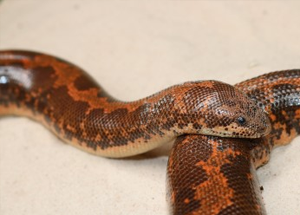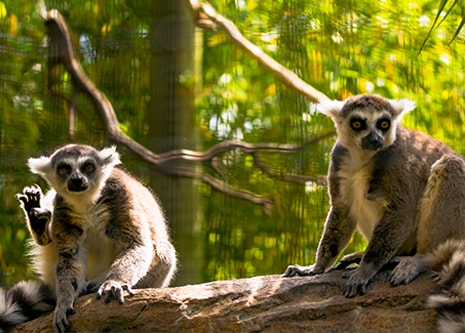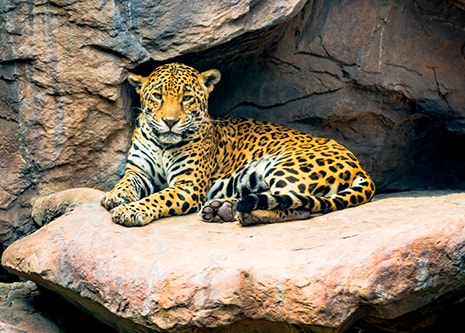
- VisitSupport Happy HollowDONATE TODAYExploreSupport Happy HollowDONATE TODAYLearnSupport Happy HollowDONATE TODAYSupport
-
Today's Hours: 10:00 am to 5:00 pm
Education AmbassadorsKenyan sand boa

Scientific name: Gongylophis colubrinus loveridgei
Family: Boidae
Order: Squamata
Class: Reptilia
Range: Eastern Africa
Habitat: Desert
Lifespan: 15 to 18 years in the wild; up to 20 years in captivityWhat do they look like?
Kenyan sand boas are stout snakes with blunt snouts and tails. Females are typically larger than males, weighing up to 2 pounds. Females can be 26 to 32 inches long while males grow up to 15 inches. Kenyan sand boas have a white or cream underbelly and orange, yellow and brown splotches along their backs. This coloration allows sand boas to camouflage with their environment and remain hidden from predators such as the desert monitor lizard. The Kenyan sand boa’s eyes and nostrils are located on top of the head. This prevents sand from entering and irritating their eyes and nose. Additionally, wedged snouts prevent sand from entering their mouths while burrowing.How do they behave?
Kenyan sand boas spend most of their time in sandy burrows with only their heads exposed. To avoid the extreme heat of their desert habitat, these snakes use their wedge-shaped heads to burrow in the cool sand during the day and hunt at night when the temperature is much lower. During the hottest months, they will seek refuge under plants, rocks, or even in the burrows of mammals. Kenyan sand boas are ambush predators, which means they hide and wait for their prey to come close to the snake’s concealed body.What do they eat?
The Kenyan sand is a non-venomous snake that uses constriction to subdue its prey. Kenyan sand boas may also suffocate their prey by dragging it beneath the sand. In the wild, Kenyan sand boas eat nestlings, small lizards and rodents such as the naked mole rat. If food is particularly scarce, the Kenyan sand boa can live for up to a year without eating. At Happy Hollow they eat mice.How are they born?
Unlike most reptile species, these snakes do not lay eggs. Instead they are ovoviviparous (give birth to live young encased in membranous sacs). Mating occurs primarily during spring and summer months. Oftentimes, males will unearth a female from the sand before mating can begin. Females have a gestation period of four months, after which they will have four to 20 young boas. These young are eight to 10 inches long and precocial, meaning they are independent at birth. Kenyan sand boas reach sexual maturity at two to three years of age.Conservation
The Kenyan sand boa’s conservation status has not been evaluated by the International Union for Conservation of Nature . While their population in the wild may be stable, excessively catching wild Kenyan sand boas for the pet trade could lead to a Near Threatened status. Wild-caught animals will often refuse to eat in captivity and can carry parasites. Poor conditions of importation often lead to stressed and aggressive animals. If you would like to help Kenyan sand boas, do not support the illegal pet trade by purchasing wild-caught snakes. Make sure potential pets are captive-bred in the United States rather than being imported from Africa. If you are considering a Kenyan sand boa as a pet, make sure to do your research and consider adopting from your local animal shelter or reptile rescue group. For more information on reptile rescue in the bay area check out the Bay Area Amphibian and Reptile Society at www.baars.org
Zoo on the Hill
Located across from the Keep-Around Carousel is the Zoo on the Hill. Learn about wildlife up close during daily meet-and-greets, leap like a lemur on the playground, brush and feed the goats,, or take a peek inside Doc’s Critter Care building and the Ranch House. Double-H Ranch features a combination of animal exhibits, including giant anteaters and red ruffed lemurs, as well chickens and domesticated animals that are docile enough to touch.
See Animals
Zoo in the Hollow
Follow the crooked bamboo pathway down into the hollow and visit with some of the most amazing animals in the world. Where else in San José can you get up close to a stunning jaguar, lemur, meerkat or American alligator? Happy Hollow is dedicated to helping save species and preserve wildlife for future generations by participating in Species Survival Plan programs through the Association of Zoos and Aquariums.
See AnimalsVisit Us Today
Plan an unforgettable experience at San Jose’s family-friendly park and zoo.
more info